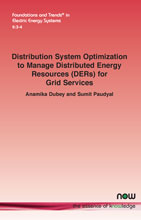Distribution System Optimization to Manage Distributed Energy Resources (DERs) for Grid Services
By Anamika Dubey, Washington State University, USA, anamika.dubey@wsu.edu | Sumit Paudyal, Florida International University, USA, spaudyal@fiu.edu
Abstract
The proliferation of distributed energy resources (DERs) and the deployment of advanced sensing and control technologies in electric power distribution systems calls for coordinated management of the grid’s resources. This has sparked a growing interest in optimization methods for large-scale unbalanced power distribution systems, with the goal of improving grid’s operational efficiency and resilience. The current fast-paced research in this domain is driven by the challenging mathematical problem of three-phase optimal power flow (OPF). This monograph introduces the state-of-the-art optimization methods applied to unbalanced power distribution systems for the provisioning of grid services from DERs. To that end, fundamentals of D-OPF methods are introduced along with the unique challenges and differences compared to the bulk grid and related aspects of computational complexity due to mutual coupling, unbalanced loading conditions, and control of legacy devices. Different models for formulating D-OPF problems are described in detail, as are methods for relaxing or approximating the formulations to achieve computational tractability. Finally, the use of D-OPF formulations to solve distribution-level operational problems via advanced distribution-level applications is described in detail. The specific applications discussed in this monograph include: (1) Volt-VAR control and Conservation Voltage Reduction using legacy voltage control devices and DERs, and (2) Solutions for Tomorrow’s Grid Reconfiguration and Restoration using DERs.
Distribution System Optimization to Manage Distributed Energy Resources (DERs) for Grid Services
Recent fire-related damages and fatalities caused by high-voltage transmission lines coupled with dry weather are costing billions of dollars annually, with the only practical solution being de-energizing the lines and disrupting the power supply to millions of customers. The recent advances in the distribution grid, including the integration of distributed generation (DGs), distributed energy resources (DERs), and microgrids, provide potential means to improve the grid’s operational resilience. An advanced decision-support system is needed to plan and manage grid operations by proactively managing the grid’s variable, uncertain, and distributed resources. Consequently, resilient operational solutions for power distribution grids have drawn significant attention. These applications range from leveraging recent advances in smart grid technology, such as remote control capabilities and DER integration, to enabling advanced grid services such as frequency and voltage support for the bulk grid and resilient operations through intentional islanding to support critical services during disruptions.
This monograph provides a much-needed primer on optimization methods used in active power distribution systems for advanced operations, with the goal of benefiting researchers working in this field. The graduate students and young researchers working in the area of DERs and distribution systems operations need a background on not only topics related to power distribution engineering but also a wide variety of interdisciplinary subjects to address the upcoming challenges. The monograph will benefit a diverse pool of researchers and industry practitioners by building the necessary background on modeling the distribution systems (with DERs) and system optimization methods for provisioning grid services.
